IM532 3.0 Applied Time Series Forecasting
MSc in Industrial Mathematics
Introduction to ARIMA models
8 March 2020
Stochastic processes
"A statistical phenomenon that evolves in time according to probabilistic laws is called a stochastic process." (Box, George EP, et al. Time series analysis: forecasting and control.)
Stochastic processes
"A statistical phenomenon that evolves in time according to probabilistic laws is called a stochastic process." (Box, George EP, et al. Time series analysis: forecasting and control.)
Non-deterministic time series or statistical time series
A sample realization from an infinite population of time series that could have been generated by a stochastic process.
Stochastic processes
"A statistical phenomenon that evolves in time according to probabilistic laws is called a stochastic process." (Box, George EP, et al. Time series analysis: forecasting and control.)
Non-deterministic time series or statistical time series
A sample realization from an infinite population of time series that could have been generated by a stochastic process.
Probabilistic time series model
Let {X1,X2,...} be a sequence of random variables. Then the joint distribution of the random vector [X1,X2,...,Xn]′ is
P[X1≤x1,X2≤x2,...,Xn≤xn]
where −∞<x1,...,xn<∞ and n=1,2,...
Mean function
Mean function
The mean function of {Xt} is
μX(t)=E(Xt).
Mean function
The mean function of {Xt} is
μX(t)=E(Xt).
Covariance function
The covariance function of {Xt} is
γX(r,s)=Cov(Xr,Xs)=E[(Xr−μX(r))(Xs−μX(s))]
for all integers r and s.
Mean function
The mean function of {Xt} is
μX(t)=E(Xt).
Covariance function
The covariance function of {Xt} is
γX(r,s)=Cov(Xr,Xs)=E[(Xr−μX(r))(Xs−μX(s))]
for all integers r and s.
The covariance function of {Xt} at lag h is defined by γX(h):=γX(h,0)=γ(t+h,t)=Cov(Xt+h,Xt).
Autocovariance function
The auto covariance function of Xt at lag h is
γX(h)=Cov(Xt+h,Xt).
Autocovariance function
The auto covariance function of Xt at lag h is
γX(h)=Cov(Xt+h,Xt).
Autocorrelation function
The autocorrelation function of Xt at lag h is
ρX(h)=γX(h)γX(0)=Cor(Xt+h,Xt).
Weekly stationary
A time series {Xt} is called weekly stationary if
μX(t) is independent of t.
γX(t+h,t) is independent of t for each h.
In other words the statistical properties of the time series (mean, variance, autocorrelation, etc.) do not depend on the time at which the series is observed, that is no trend or seasonality. However, a time series with cyclic behaviour (but with no trend or seasonality) is stationary.
Weekly stationary
A time series {Xt} is called weekly stationary if
μX(t) is independent of t.
γX(t+h,t) is independent of t for each h.
In other words the statistical properties of the time series (mean, variance, autocorrelation, etc.) do not depend on the time at which the series is observed, that is no trend or seasonality. However, a time series with cyclic behaviour (but with no trend or seasonality) is stationary.
Strict stationarity of a time series
A time series {Xt} is called weekly stationary if the random vector [X1,X2...,Xn]′ and [X1+h,X2+h...,Xn+h]′ have the same joint distribution for all integers h and n>0.
Simple time series models
1. iid noise
no trend or seasonal component
observations are independent and identically distributed (iid) random variables with zero mean.
Notation: {Xt}∼IID(0,σ2)
plays an important role as a building block for more complicated time series.
Joint distribution function of iid noise
P[X1≤x1,X2≤x2,...,Xn≤xn]=P[X1≤x1]....P[Xn≤xn].
Simple time series models
1. iid noise
no trend or seasonal component
observations are independent and identically distributed (iid) random variables with zero mean.
Notation: {Xt}∼IID(0,σ2)
plays an important role as a building block for more complicated time series.
Joint distribution function of iid noise
P[X1≤x1,X2≤x2,...,Xn≤xn]=P[X1≤x1]....P[Xn≤xn]. Let FX(.) be the cumulative distribution function of each of the identically distributed random variables X1,X2,... Then, P[X1≤x1,X2≤x2,...,Xn≤xn]=FX(x1)...FX(xn)
Simple time series models
1. iid noise
no trend or seasonal component
observations are independent and identically distributed (iid) random variables with zero mean.
Notation: {Xt}∼IID(0,σ2)
plays an important role as a building block for more complicated time series.
Joint distribution function of iid noise
P[X1≤x1,X2≤x2,...,Xn≤xn]=P[X1≤x1]....P[Xn≤xn]. Let FX(.) be the cumulative distribution function of each of the identically distributed random variables X1,X2,... Then, P[X1≤x1,X2≤x2,...,Xn≤xn]=FX(x1)...FX(xn) There is no dependence between observations. Hence, P[Xn+h≤x|X1=x1,...,Xn=xn]=P[Xn+h≤x].
iid noise (cont.)
Examples of iid noise
Sequence of iid random variables {Xt,t=1,2,...} with P(Xt=1)=12 and P(Xt=0)=12.
rnorm(15) [1] 2.61665472 -1.47748881 -0.75695121 -1.70520956 -1.02075354 0.81739417 [7] 0.01909737 -1.29025062 0.84205925 0.27636792 -1.37133390 -0.89830051[13] -0.62070173 0.15142641 0.40849453iid noise (cont.)
Examples of iid noise
Sequence of iid random variables {Xt,t=1,2,...} with P(Xt=1)=12 and P(Xt=0)=12.
rnorm(15) [1] 2.61665472 -1.47748881 -0.75695121 -1.70520956 -1.02075354 0.81739417 [7] 0.01909737 -1.29025062 0.84205925 0.27636792 -1.37133390 -0.89830051[13] -0.62070173 0.15142641 0.40849453Question
Let {Xt} is a iid noise with E(X2)=σ2<∞. Show that {Xt} is a stationary process.
Simple time series models
2. White noise
If {Xt} is a sequence of uncorrelated random variables, each with zero mean and variance σ2, then such a sequence is referred to as white noise.
Note: Every IID(0,σ2) sequence is WN(0,σ2) but not conversely.
Simple time series models
3. Random walk
A random walk process is obtained by cumulatively summing iid random variables. If {St,t=0,1,2,...} is a random walk process, then S0=0
S1=0+X1
S2=0+X1+X2
...
St=X1+X2+...+Xt.
Simple time series models
3. Random walk
A random walk process is obtained by cumulatively summing iid random variables. If {St,t=0,1,2,...} is a random walk process, then S0=0
S1=0+X1
S2=0+X1+X2
...
St=X1+X2+...+Xt.
Question
Is {St,t=0,1,2,...} a weak stationary process?
Identifying non-stationarity in the mean
Using time series plot
ACF plot
ACF of stationary time series will drop to relatively quickly.
The ACF of non-stationary series decreases slowly.
For non-stationary series, the ACF at lag 1 is often large and positive.
Elimination of Trend and Seasonality by Differencing
- Differencing helps to stabilize the mean.
Backshift notation:
BXt=Xt−1
Ordinary differencing
The first-order differencing can be defined as
∇Xt=Xt−Xt−1=Xt−BXt=(1−B)Xt where ∇=1−B.
The second-order differencing
∇2Xt=∇(∇Xt)=∇(Xt−Xt−1)=∇Xt−∇Xt−1=(Xt−Xt−1)−(Xt−1−Xt−2)
- In practice, we seldom need to go beyond second order differencing.
Seasonal differencing
- differencing between an observation and the corresponding observation from the previous year.
∇mXt=Xt−Xt−m=(1−Bm)Xt where m is the number of seasons. For monthly, m=12, for quarterly m=4.
For monthly series
∇12Xt=Xt−Xt−12
Twice-differenced series
∇212Xt=∇12Xt−∇12Xt−1=(Xt−Xt−12)−(Xt−1−Xt−13)
If seasonality is strong, the seasonal differencing should be done first.
Original series

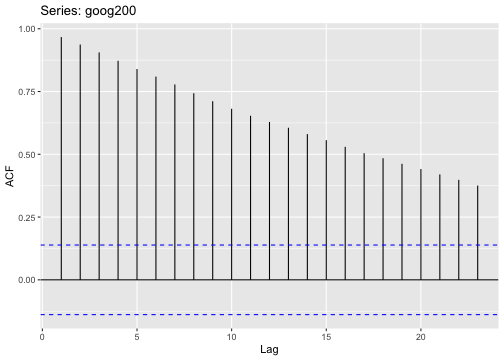
Differenced series

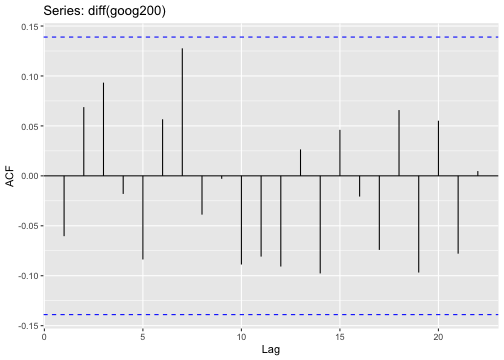
- For a stationary time series, the ACF will drop to zero relatively quickly, while the ACF of non-stationary data decreases slowly.
Original series

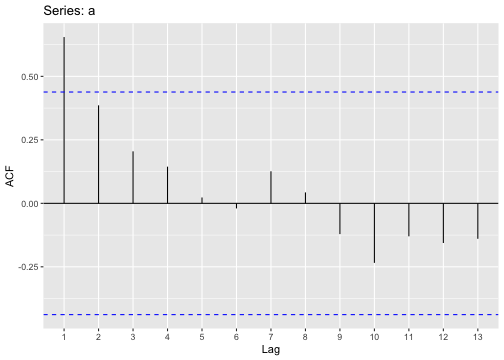
Differenced series

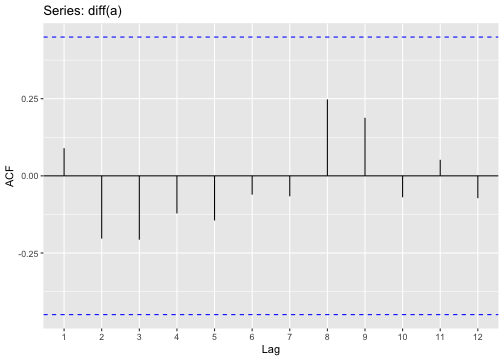
Original series

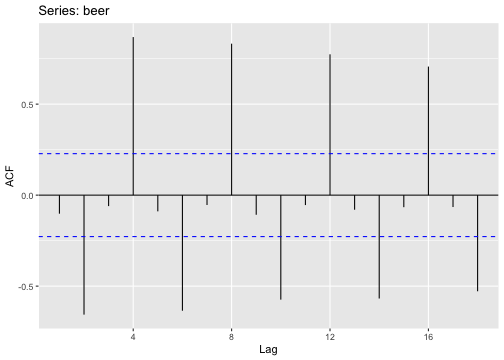
Seasonal Differencing

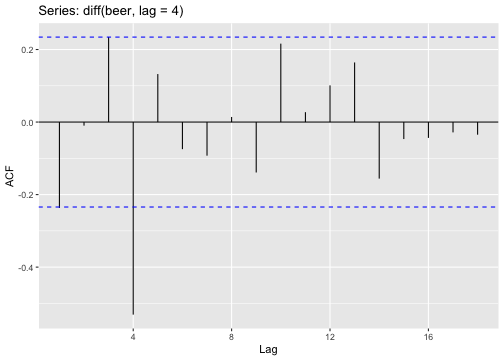
Linear filter model
A linear filter is an operation L which transform the white noise process into another time series {Xt}.
White noise ϵt → Linear Filter ψ(B) → Output Xt
Autoregressive models
current value = linear combination of past values + current error
An autoregressive model of order p, AR(P) model can be written as
xt=c+ϕ1xt−1+ϕ2xt−2+...+ϕpxt−p+ϵt, where ϵt is white noise.
- Similar to multiple linear regression model but with lagged values of xt as predictors.
Autoregressive models
current value = linear combination of past values + current error
An autoregressive model of order p, AR(P) model can be written as
xt=c+ϕ1xt−1+ϕ2xt−2+...+ϕpxt−p+ϵt, where ϵt is white noise.
- Similar to multiple linear regression model but with lagged values of xt as predictors.
Question
Show that AR(P) is a linear filter with transfer function ϕ−1(B), where ϕ(B)=1−ϕ1B−ϕ2B2−...−ϕpBp.
Autoregressive models
current value = linear combination of past values + current error
An autoregressive model of order p, AR(P) model can be written as
xt=c+ϕ1xt−1+ϕ2xt−2+...+ϕpxt−p+ϵt, where ϵt is white noise.
- Similar to multiple linear regression model but with lagged values of xt as predictors.
Question
Show that AR(P) is a linear filter with transfer function ϕ−1(B), where ϕ(B)=1−ϕ1B−ϕ2B2−...−ϕpBp.
Stationary condition for AR(P)
The roots of ϕ(B)=0 (characteristic equation) must lie outside the unit circle.
Stationarity Conditions for AR(1)
Let's consider AR(1) process,
xt=ϕ1xt−1+ϵt.
Then,
(1−ϕ1B)xt=ϵt.
This may be written as, xt=(1−ϕ1B)−1ϵt=∞∑j=0ϕj1ϵt−j. Hence,
ψ(B)=(1−ϕ1B)−1=∞∑j=0ϕj1Bj
If |ϕ1|<1, the AR(1) process is stationary.
This is equivalent to saying the roots of 1−ϕ1B=0 must lie outside the unit circle.
Geometric series
a+ar+ar2+ar3+...=a1−r
for |r|<1.
AR(1) process
xt=c+ϕ1xt−1+ϵt,
when ϕ1=0 - equivalent to white noise process
when ϕ1=0 and c=0 - random walk
when ϕ1=1 and c≠0 - random walk with drift
when ϕ1<0 - oscillates around the mean
Find the mean, variance and the autocorrelation function of a AR(1) process.
Help:
Cov(X+Y,X+Y)=Var(X+Y)=Var(X)+Var(Y)+2Cov(X,Y) Cov(X,Y)=E[(X−μX)(Y−μY)]
Question: Properties of AR(2) process
Find the Mean, Variance and Autocorrelation function.
Yule-Walker Equations
Autoregressive parameters in terms of the autocorrelations.
Autocorrelation function of a AR(P) process
The autocorrelation function of AR(P) process
ρk=ϕ1ρk−1+ϕ2ρk−2+...+ϕpρk−p for k>0.
This can be written as
ϕ(B)ρk=0, where ϕ(B)=1−ϕ1B−...−ϕpBp.
For AR(1) process
ρk=ϕ1ρk−1, for k>0. Since ρ0=1, for k≥1, we get
ρk=ϕk1
When ϕ1>0, autocorrelation function decays exponentially to zero.
When ϕ1<0, autocorrelation function decays exponentially to zero and oscillates in sign.
Partial Autocorrelation Function
Conditional autocorrelation between Xt and Xt−k given that Xt+1,Xt+2,...,Xt+k−1.
Cor(Xt,Xt+k|Xt+1,Xt+2,...,Xt+k−1)
The partial autocorrelation function ϕkk of AR(P) will be non-zero for k less than or equal to p and zero for k greater than p.
Calculations: in-class
Moving average models
Current value = linear combination of past forecast errors + current error
An MA(q) process can be written as
xt=c+ϵt+θ1ϵt−1+θ2ϵt−2+...+θpϵt−q where ϵt is white noise.
The current value xt can be thought of as a weighted moving average of the past few forecast errors.
MA(q) is always stationary.
Moving average models
Current value = linear combination of past forecast errors + current error
An MA(q) process can be written as
xt=c+ϵt+θ1ϵt−1+θ2ϵt−2+...+θpϵt−q where ϵt is white noise.
The current value xt can be thought of as a weighted moving average of the past few forecast errors.
MA(q) is always stationary.
- Any AR(p) model can be written as an MA(∞) model using repeated substitution.
Invertibility condition of an MA model
xt=c+ϵt+θ1ϵt−1+θ2ϵt−2+...+θpϵt−q Using back shift operator, xt=c+ϵt+θ1Bϵt+θ2B2ϵt+...+θpBqϵt
Hence,
xt=θq(B)ϵt+c.
The θq is defined as an MA operator.
Any MA(q) process can be written as an AR(∞) process if we impose some constraints on the MA parameters. Then it is called invertible.
MA model is called invertible if the roots of θq(B)=0 lie outside the unit circle.
MA(1) process
Obtain the invertibility condition of MA(1) process.
Calculate mean, variance, ACF and PACF of MA(1) process.
MA(2) process
Calculate mean, variance, ACF and PACF of MA(2) process.
ACF and PACF of AR(p) v MA(q) process
AR(p)
ACF: decays exponentially to zero.
PACF: PACF of AR(p) process is zero, beyond the order p of the process/ cut-off after lag p.
MA(q)
ACF: ACF of MA(q) process is zero, beyond the order q of the process/ cut-off after lag q.
PACF: decays exponentially to zero.
ARMA process
current value = linear combination of past values + linear combination of past error + current error
The ARMA(p,q) can be written as
Xt=c+ϕ1xt−1+ϕ2xt−2+...+ϕpxt−p+θ1ϵt−1+θ2ϵt−2+...+θqϵt−q+ϵt, where {ϵt} is a white noise process.
Using the back shift operator
ϕ(B)xt=θ(B)ϵt, where ϕ(.) and θ(.) are the pth and qth degree polynomials,
ϕ(B)=1−ϕ1ϵ−...−ϕpϵp, and θ(B)=1+θ1ϵ+...+θqϵq.
ARMA(p, q) process
Stationary condition
Roots of ϕ(B)=0 lie outside the unit circle.
Invertible condition
Roots of θ(B)=0 lie outside the unit circle.
Question:
Determine which of the following processes are invertible and stationary.
xt=0.6xt−1+ϵt
xt=ϵt−1.3ϵt−1+0.4ϵt−2
xt=0.6xt−1−1.3ϵt−1+0.4ϵt−2+ϵt
xt=xt−1−1.3ϵt−1+0.3ϵt−2+xt
ARMA(1, 1) model
Calculate the mean,variance and ACF of ARMA(1, 1) process.
Non-seasonal ARIMA models
- Autoregressive Integrated Moving Average Model
x′t=c+ϕ1x′t−1+...+ϕpx′t−p+θ1ϵt−1+...+θqϵt−q+ϵt, where x′t is the difference series.
Using the back shift notation
(1−ϕ1B−...−ϕpBp)(1−B)dxt=c+(1+θ1B+...+θqBq)ϵt
We call this an ARIMA(p,d,q) model.
p - order of the autoregressive part
d - degree of first differencing involved
q - order of the moving average part
Seasonal ARIMA model
Seasonal differencing
For monthly series
(1−B12)xt=xt−xt−12
For quarterly series
(1−B4)xt=xt−xt−4
Non-seasonal differencing
(1−B)xt=xt−xt−1
Multiply terms together
(1−B)(1−Bm)xt=(1−B−Bm+Bm+1)xt=xt−xt−1−xt−m+xt−m−1.
Seasonal ARIMA models
ARMA(p,d,q)(P,D,Q)m
(p,d,q) - non-seasonal part of the model
(P,D,Q) - seasonal part of the model
m - number of observations per year
ARIMA(1,1,1)(1,1,1)4
(1−ϕ1B)(1−Φ1B4)(1−B)(1−B4)xt=(1+θ1B)(1+Θ1B4)ϵt
(1−ϕ1B) - Non-seasonal AR(1)
(1−Φ1B4) - Seasonal AR(1)
(1−B) - Non-seasonal difference
(1−B4) - Deasonal difference
(1+θ1B) - Non-seasonal MA(1)
(1+ΘB4) - Seasonal MA(1)
Question
- Write down the model for
ARIMA(0,0,1)(0,0,1)12 ARIMA(1,0,0)(1,0,0)12